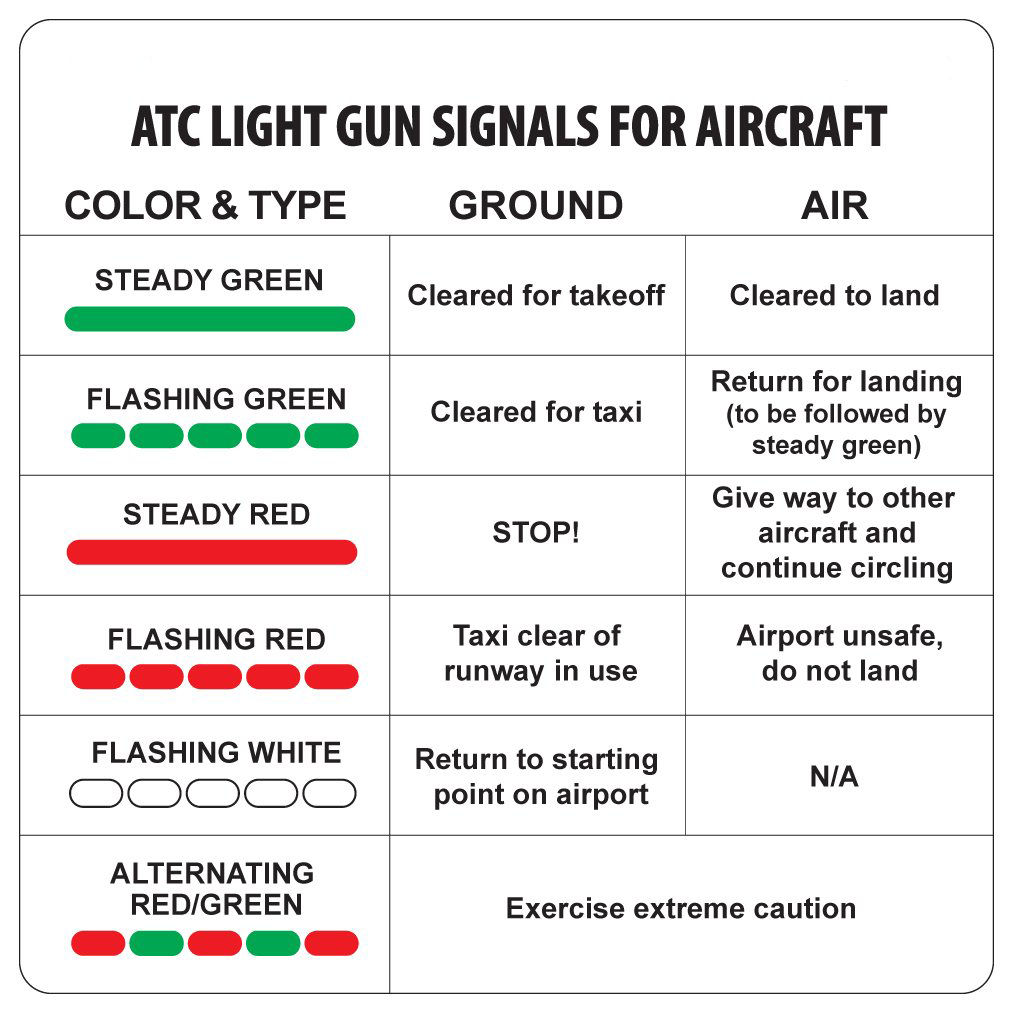Air traffic controllers use light gun signals to communicate essential instructions to non-radio aircraft, ground vehicles, and people within the airfield perimeter. These signals are crucial for  aircraft without radios or those experiencing a radio failure. Additionally, light gun signals serve as a backup communication method in case of ATC radio equipment failure, ensuring safety and smooth operations at the airfield.
aircraft without radios or those experiencing a radio failure. Additionally, light gun signals serve as a backup communication method in case of ATC radio equipment failure, ensuring safety and smooth operations at the airfield.
Light gun signals emit a bright light visible from great distances, allowing air traffic controllers to issue instructions or warnings to pilots. The signal may be transmitted using a handheld directional lamp operated by an air traffic controller in the tower or on the apron, or it may come from a beacon fixed to the tower. For students enrolled in flying classes or any pilot aviation academy, it’s beneficial to familiarize yourself with these signals. A great way to do this is by calling your local tower and asking to see the light gun signals in action. This hands-on experience helps ensure you're prepared to recognize these signals during flight lessons or during aviation training.
Signal Colors and Indications
The light gun signals use three colors: red, green, and white. Aircraft on the ground and in the air interpret these signals differently depending on whether they are steady or flashing.
-
Steady red light gun signal
A pilot in flight receiving a steady red signal should give way to other aircraft and continue circling. This signal often indicates that continuing to land would not be safe. The pilot should comply with the order and maintain a vigilant lookout for any nearby aircraft and the next signal from air traffic controllers.
For aircraft or ground vehicles observing this signal, stopping immediately is mandatory. If there is ground traffic nearby, a complete stop is advised. It's important for anyone pursuing a private pilot license or FAA pilot license to understand these procedures thoroughly, as they are essential during both flying lessons and actual flight scenarios.
-
Flashing red light gun signal
A flashing red signal from the control tower indicates that landing is risky for an aircraft in the air. There could be many different explanations for why this might be the case. On the runway, for instance, there can be trash or animals.
Aircraft on the ground should taxi away from the active runway, and ground vehicles should move away from the runway or taxiway.
-
Steady green light gun signal

A steady green light directed at an aircraft in flight confirms it is safe to land, indicating that the runway is clear. This signal also clears aircraft on the ground for takeoff and ground vehicles and personnel to proceed.
-
Flashing green light gun signal
People frequently get caught off guard by this one because green is frequently connected to safety. To return for a landing at the airfield is the actual directive concealed behind a flashing green light pointed at an aircraft in the air. Typically, ATC sends this alert to nearby planes. The pilot should keep a close eye out for a steady green, which denotes that landing is safe if it is visible.
A flashing green light on the ground signals that it is safe for the plane to taxi. To personnel or ground vehicles, it sends no signals.
-
Flashing white light gun signal
A flashing white light on an airplane in the air has no significance under Federal Aviation Administration standards.
An airplane should land at the airfield and proceed to the apron if the white light is flashing, according to International Civil Aviation Organization regulations. It is not, however, permission to land or taxi. The continuous green and flashing green signals that should appear after this instruction should be seen by the pilot.
A flashing white light alerts ground-based vehicles, aircraft, and people to return to the airfield's starting location.
A constant white light has no significance and may be misinterpreted as a signal by ATC if it were utilized as such.
-
Alternating red and green signals
A pilot who sees alternating red and green lights in the vicinity of an airfield should exercise extreme caution. ATC uses this combination as a general warning signal, which usually indicates a serious problem on the airfield or within its airspace. There could be a hazard caused by converging aircraft, a mechanical problem with the aircraft the pilot has not noticed, or airfield or runway obstructions.
The FAA notes that this signal is to warn, not prohibit. Accordingly, ATC may follow this signal with another one.
Acknowledging Light Gun Signals
During the day, the pilot in command can acknowledge a light gun signal by moving the ailerons or the rudder. At night the PIC can switch the navigation lights or the landing light off and on again.
ATC issues all these light gun signal warnings and instructions with the provision that the pilot remains in command. Ultimately, the safety of the aircraft and its passengers remains their responsibility.


.png?width=178&height=50&name=Aviator%20Zone%20Academy%20(5).png)